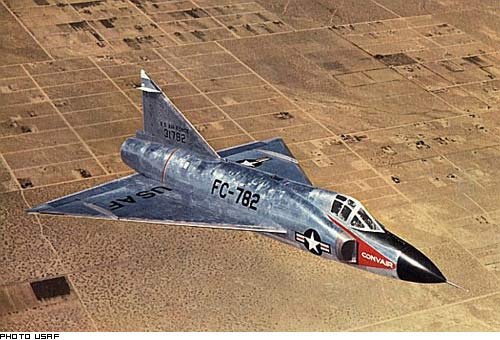F-102 Delta Dagger
Summary
| Category | Combat Aircraft |
| Origin country | 🇺🇸 United States |
| Manufacturer | Convair |
| First flight | 24 October 1954 |
| Year introduced | 1956 |
| Number produced | 1000 units |
| Average unit price | $2.5 million |
Description
The F-102 was designed in response to a United States Air Force (USAF) requirement, the "1954 Ultimate Interceptor," intended to serve as the backbone of American air defenses against Soviet strategic bombers like the Tupolev Tu-95 during the Cold War. Convair was selected as the primary manufacturer, leveraging their early research into delta-winged aircraft. The aircraft was developed alongside a sophisticated fire-control system, though a simplified unit was initially adopted due to development challenges. The F-102 was innovative for its time, featuring an internal weapons bay, a relatively unorthodox design choice aimed at reducing drag. The prototype YF-102 made its maiden flight on 23 October 1953, but was lost in an accident nine days later. Flight testing with the second prototype revealed that, as originally designed, the aircraft was unable to achieve Mach 1 supersonic flight, prompting a major redesign to incorporate the area rule, reshaping the fuselage and wings. The redesigned F-102 demonstrated performance improvements sufficient to warrant continued production, leading to a new contract in March 1954 and entry into USAF service in 1956, replacing subsonic interceptors such as the Northrop F-89 Scorpion.
The F-102A was designed without any internal gun armament, relying solely on air-to-air missiles and rockets as its primary offensive capability. It featured a three-segment internal weapons bay located under the fuselage. The initial armament configuration consisted of three pairs of GAR-1/2/3/4 (later re-designated as AIM-4) Falcon missiles, which included both infrared homing and semi-active radar homing variants. The doors of the two forward bays were equipped with tubes capable of housing 24 2.75-inch (70 mm) Folding-Fin Aerial Rockets (FFAR). Later upgrades allowed the F-102A to carry up to two GAR-11/AIM-26 Nuclear Falcon missiles in the center bay, necessitating redesigned center bay doors without rocket tubes due to the larger size of the nuclear-tipped weapon. Although plans were considered to equip the design with the MB-1 Genie nuclear rocket, and one was test fired from a YF-102A in May 1956, it was never adopted for operational service. Constructed with the Hughes MC-3 fire control system, later upgraded to the MG-10, throughout its service life, the F-102 was retrofitted with infra-red search and tracking systems, radar warning receivers, transponders, and improvements to its fire control system, with considerations given to a close-support version featuring an internal Gatling gun and additional hardpoints for bombs, although this was never implemented.
The F-102 saw operational use starting in June 1956, with the 327th Fighter-Interceptor Squadron at George Air Force Base being the first unit equipped. Deployments included Thule Air Base in Greenland for intercepting Soviet aircraft, and assignments to units in Europe and Iceland, where it remained in service through the early 1970s. F-102s participated in the Vietnam War, initially providing fighter patrols and bomber escorts, and later, ground-attack sorties; a total of 14 aircraft were lost in Vietnam due to air-to-air combat, ground fire, and accidents. It was supplemented by McDonnell F-101 Voodoos and, later on, by McDonnell Douglas F-4 Phantom IIs. The F-102 was also exported to Turkey and Greece, with Turkish F-102s seeing combat during the 1974 Turkish invasion of Cyprus.
Main Variants:
-
YF-102: These were the initial prototypes of the F-102, featuring a non-area-ruled fuselage and powered by a 14,500 lbf (64.5 kN) J57-P-11 engine.
-
YF-102A: These prototypes incorporated the area rule in their design and were powered by a more potent 16,000 lbf (71.2 kN) J57-P-23 engine, with four conversions made from pre-production aircraft.
-
F-102A: This was the primary production model, with the initial eight pre-production aircraft retaining a non-area-ruled fuselage, while the remaining 879 were built with the improved area-ruled design.
-
TF-102A: This variant served as a two-seat training version, accommodating a side-by-side seating arrangement for the instructor and trainee, with a total of 111 aircraft manufactured.
-
QF-102A: A number of F-102A were converted into QF-102A target drones, to simulate enemy aircraft, for weapon systems testing.
Technical specifications
| Version: F-102A | |
|---|---|
| Crew | 1 pilot |
| Operational range | 2,175 km (1,351 mi) |
| Maximum speed | 1328 km/h (825 mph) |
| Wing area | 61.5 m² (662.2 sqft) |
| Wingspan | 11.6 m (38.1 ft) |
| Height | 6.5 m (21.2 ft) |
| Length | 20.8 m (68.3 ft) |
| Service ceiling | 16,276 m (53,399 ft) |
| Empty weight | 8,777 kg (19,350 lbs) |
| Max. takeoff weight | 14,288 kg (31,500 lbs) |
| Climb rate | 66.0 m/s (216.5 ft/s) |
| Powerplant | 1 x turbojet Pratt & Whitney J57-P-25 delivering 5307 kgf each |
| Ejection seat | Weber We-Convair |
Current operating countries
All operators
Armament
Missiles payload:
- Air-to-Air Short-Range AIM-4 Falcon
- Air-to-Air Short-Range AIM-26 Falcon

